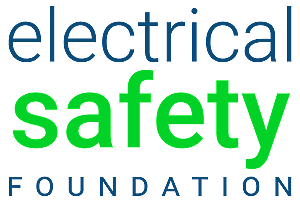As the industry leader in electrical safety, ESFI has a firm commitment to electrical safety education. From game consoles to computers to cell phones, electricity is an increasing presence in our lives, and more electricity usage means more potential hazards. To effectively teach about safe practices with electricity, ESFI realizes that it is imperative to teach not only about electrical safety, but about electricity itself. Other electrical safety websites focus on memorizing a set of safety rules in a vacuum, with limited or incomplete background information about electricity. ESFI’s approach is a uniquely comprehensive one, centered on the concept that there is greater success in learning and implementing rules when there is a thought process behind it (“Thoughtful Learning,” Smart Schools, 1998). As our electricity-dependent environments continue to grow, students will be able to use the knowledge gained through ESFI’s website to anticipate and avoid electrical dangers.
To ensure the successful teaching and learning of electricity, ESFI has designed the lessons to satisfy the leading educational standards without the need for additional resources. First, the lessons meet the McRel National Educational Standards for electricity (science standard 9 /I/3) and scientific inquiry and knowledge (science standard 11/I/2, 13/I/1) for grades K-5 (www.mcrel.org/compendium/…),as well as the National Educational Standards for Physical Science regarding electricity (standard B/3) for similar grades (www.nap.edu). Second, the lessons are designed regardless of the teacher’s background, in that the teachers do not need to be scientists or be scientifically proficient. And third, the lessons are designed regardless of socioeconomic status of student or school, in that advanced technology (e.g. high speed internet, etc.) is not necessary to achieve educational success.
ESFI knows that the key is how the information is passed onto teacher and student alike. As such, ESFI has created the lessons based on two widely successful educational theories. The theory of Multiple Intelligences asserts that there are many kinds of “smart,” and that children learn through different approaches (Howard Gardner, Frames of Mind, 1983). The second theory known as Theory One asserts that students learn better when thinking comes before the knowledge acquired (Perkins, Smart Schools: Better Thinking and Learning For Every Child, 1992). ESFI incorporates both powerful and proven educational theories into lessons that achieve the following:
- Provide clear goals and instruction for each lesson (what is electricity, electrical safety indoors, and electrical safety outdoors) for each age group (K-2, and 3-5).
- Place a main activity at the center of each lesson. The activity does not occur after a lecture on the topic (as in the conventional way of teaching on the subject), but rather the activity itself is the platform to teach the topic.
- Provide a kinesthetic approach to learning. The student “experiences” being in an electrical circuit, “experiences” electricity, and therefore will better understand the concept and the safety issues involved.
- Provide follow-up activities/discussions to reinforce what has been learned. This allows the teacher to identify and rectify any potential gaps in understanding.
- Allow students to take the responsibility of electrical safety into their own hands. By understanding the rationale behind electrical safety (e.g. why a frayed cord is dangerous, etc.), students will have the ability to extend their knowledge to any new real-life situation.
- Incorporate collaborative learning, where the student explores in a group setting.
- Provide lessons that can be easily taught, regardless of previous knowledge by student or teacher, and regardless of class size.
By integrating electricity and electrical safety lessons, ESFI creates a one-stop resource for teachers, educators, parents, and students. By developing the lessons through a sound system of educational techniques, ESFI extends its high level of commitment to fostering safe practices in our increasingly electricity-dependent lives.
Bibliography
Perkins, David. Smart Schools: Better Thinking and Learning for Every Child. Chs 1-5. Copyright 1995 Free Press.
Gardner, Howard. Frames of Mind: The Theory of Multiple Intelligences. Copyright 1993 (10th Edition) Basic Press.
National Committee on Science Education Standards and Assessment, National Research Council, National Science Education Standards. Copyright 1996, The National Academies Press.
The National Academies Press, National Academies: Advisors to the Nation on Science, Engineering, and Medicine. Copyright 2010, National Academies Press.< www.nap.edu>
Mid-continent Research for Education and Learning (McRel): “Content Knowledge: Electricity and Magnetism.” Copyright 2010, McRel.<
www.mcrel.org>
Harvard-Smithsonian Center for Astrophysics. “Minds of our Own: Can we Believe our Eyes?” Video Documentary produced in 1997.




